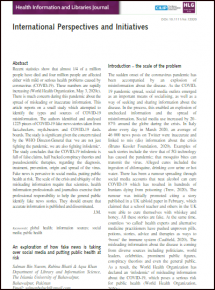An Exploration of How Fake News is Taking over Social Media and Putting Public Health at Risk
This article reports on a small study which attempted to identify the types and sources of COVID‐19 misinformation.
The authors identified and analysed 1225 pieces of COVID‐19 fake news stories taken from fact‐checkers, myth‐busters and COVID‐19 dashboards.
The study concludes that the COVID‐19 infodemic is full of false claims, half backed conspiracy theories and pseudoscientific therapies, regarding the diagnosis, treatment, prevention, origin and spread of the virus. Fake news is pervasive in social media, putting public health at risk. The scale of the crisis and ubiquity of the misleading information require that scientists, health information professionals and journalists exercise their professional responsibility to help the general public identify fake news stories. They should ensure that accurate information is published and disseminated.
Last modified: July 21, 2020
Language: English

